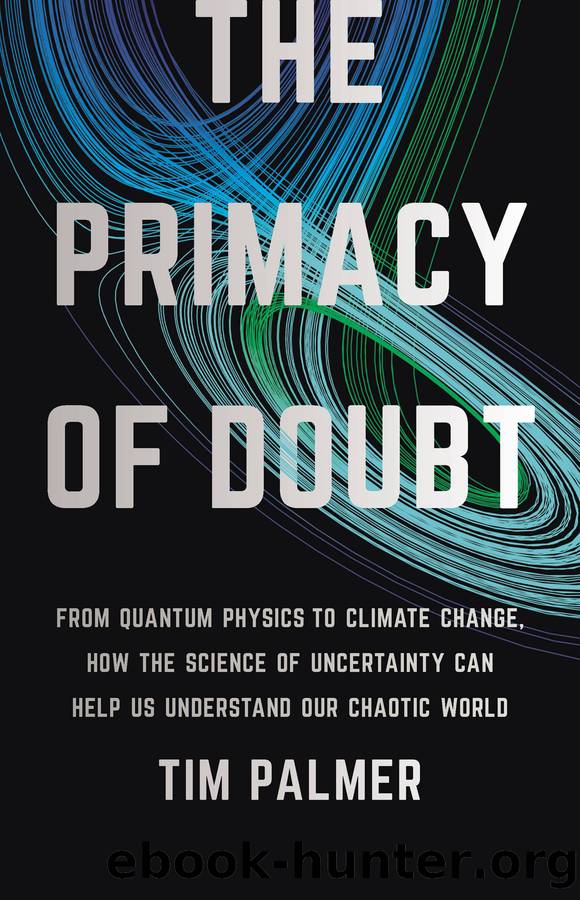The Primacy of Doubt: From Quantum Physics to Climate Change, How the Science of Uncertainty Can Help Us Understand Our Chaotic World by Tim Palmer

Author:Tim Palmer [Palmer, Tim]
Language: eng
Format: epub
Publisher: Basic Books
Published: 2022-10-18T00:00:00+00:00
Estimates of the expected numbers of deaths and hospitalisations may not be the most relevant information for policy decisions. Having a health system that essentially collapses because it is overwhelmed with new patients is something a government may not wish to risk at all. As such, plausible worst-case outcomes can be just as important, if not more so, as expected outcomes. This is similar to the situation in weather forecastingâthe averaged forecast can hide the possibility of some catastrophic weather event. Hence, for example, if we take, as an estimate of a plausible worst-case scenario, the value given by the distribution at the edge of the heavier shading (the region where, according to the ensemble, there is a two-thirds probability of occurrence), then the number of deaths rises to 60,000, well over double the prediction with best-guess parameter values.
However, Fig. 35 also illustrates a problem. As discussed, an ensemble prediction is useful only if the probabilities it generates are reliable. For the ensemble predictions I have helped develop in weather and climate science, far and away the largest part of research time was spent on developing initial-condition and model perturbations which would produce reliable probabilities. We can see in Fig. 35 that in the first hundred days or so, the actual numbers of deaths rose much more sharply than the ensemble suggested could occur. This means that the ensemble probabilities, in this case, werenât reliable. Clearly some other sources of uncertainty are important. In this case, the missing source of uncertainty is associated with the date the disease started to growâin reality it must have been growing sooner than was thought possible. That is to say, the projections used unduly certain initial conditions. This result is consistent with weather prediction, where uncertainty in the forecast initial conditions is typically more important than uncertainty in the values of model parameters.
However, there is a second type of uncertainty in these projections which is not well represented by simple parameter perturbations. For example, COVIDSim is based on a tiling of the country. Are the assumptions of homogeneity within a tiled region accurate? How small should the tiles be for this assumption to be correct? Is it ever correct? More generally, there may be many assumptions in the models where uncertainty goes far beyond simple parameter uncertainty. Such uncertainties are often referred to as âstructural model uncertaintiesâ.
This is perhaps a good time to dust off the much-repeated saying from Donald Rumsfeld, US secretary of defense at the time of the invasion of Iraq. Speaking about reports of the lack of evidence for weapons of mass destruction, he famously said in 20026:
âReports that say that something hasnât happened are always interesting to me, because as we know, there are known knowns; there are things we know we know. We also know there are known unknowns; that is to say we know there are some things we do not know. But there are also unknown unknownsâthe ones we donât know we donât know. And if one
Download
This site does not store any files on its server. We only index and link to content provided by other sites. Please contact the content providers to delete copyright contents if any and email us, we'll remove relevant links or contents immediately.
Hit Refresh by Satya Nadella(8856)
The Compound Effect by Darren Hardy(8513)
Change Your Questions, Change Your Life by Marilee Adams(7377)
Nudge - Improving Decisions about Health, Wealth, and Happiness by Thaler Sunstein(7244)
The Black Swan by Nassim Nicholas Taleb(6770)
Deep Work by Cal Newport(6563)
Daring Greatly by Brene Brown(6227)
Rich Dad Poor Dad by Robert T. Kiyosaki(6179)
Principles: Life and Work by Ray Dalio(5962)
Man-made Catastrophes and Risk Information Concealment by Dmitry Chernov & Didier Sornette(5650)
Playing to Win_ How Strategy Really Works by A.G. Lafley & Roger L. Martin(5506)
Digital Minimalism by Cal Newport;(5392)
Big Magic: Creative Living Beyond Fear by Elizabeth Gilbert(5354)
The Myth of the Strong Leader by Archie Brown(5239)
The Slight Edge by Jeff Olson(5200)
Discipline Equals Freedom by Jocko Willink(5157)
The Motivation Myth by Jeff Haden(5005)
Stone's Rules by Roger Stone(4859)
The Laws of Human Nature by Robert Greene(4777)
